Project Proposal: Consistent Network in Cape York Communities, 2024
VerifiedAdded on 2022/08/19
|9
|2172
|14
Project
AI Summary
This project proposal addresses the critical issue of inconsistent network connectivity in the remote communities of Cape York Peninsula. The assignment begins by outlining the communication problems faced by indigenous populations due to concentrated signals from existing communication towers and a lack of internet access, hindering access to online services, education, and digital literacy. Preliminary research highlights the importance of digital infrastructure for socio-economic development in rural Australia, and the challenges faced by remote communities in accessing reliable internet. The proposal then presents two design solutions: wireless internet connectivity and signal boosters for cell phone networks, explaining their functionalities and advantages. The wireless broadband solution involves antenna and modem setup, providing cost-effective access for multiple users. Signal boosters amplify existing signals to improve network coverage. The proposal also acknowledges issues for further investigation, such as user adoption, environmental impact, and cultural considerations. The report concludes by emphasizing the potential of these solutions to bridge the rural-urban digital divide and contribute to the socio-economic progress of the Cape York communities. The assignment is a response to the Engineers Without Borders (EWB) Challenge design areas, with a focus on CfAT’s work with communities in the Cape York region of Far North Queensland.
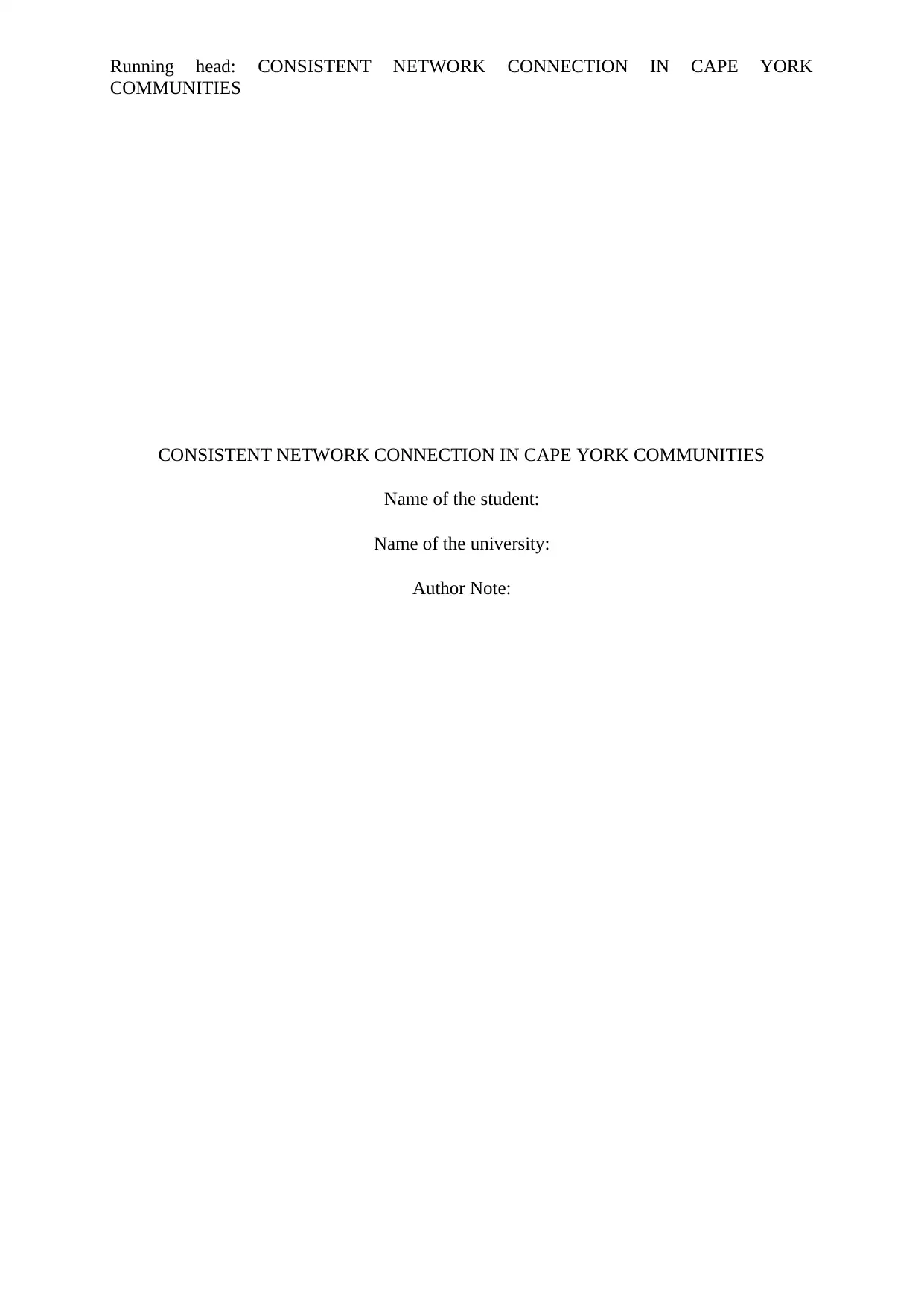
Running head: CONSISTENT NETWORK CONNECTION IN CAPE YORK
COMMUNITIES
CONSISTENT NETWORK CONNECTION IN CAPE YORK COMMUNITIES
Name of the student:
Name of the university:
Author Note:
COMMUNITIES
CONSISTENT NETWORK CONNECTION IN CAPE YORK COMMUNITIES
Name of the student:
Name of the university:
Author Note:
Paraphrase This Document
Need a fresh take? Get an instant paraphrase of this document with our AI Paraphraser
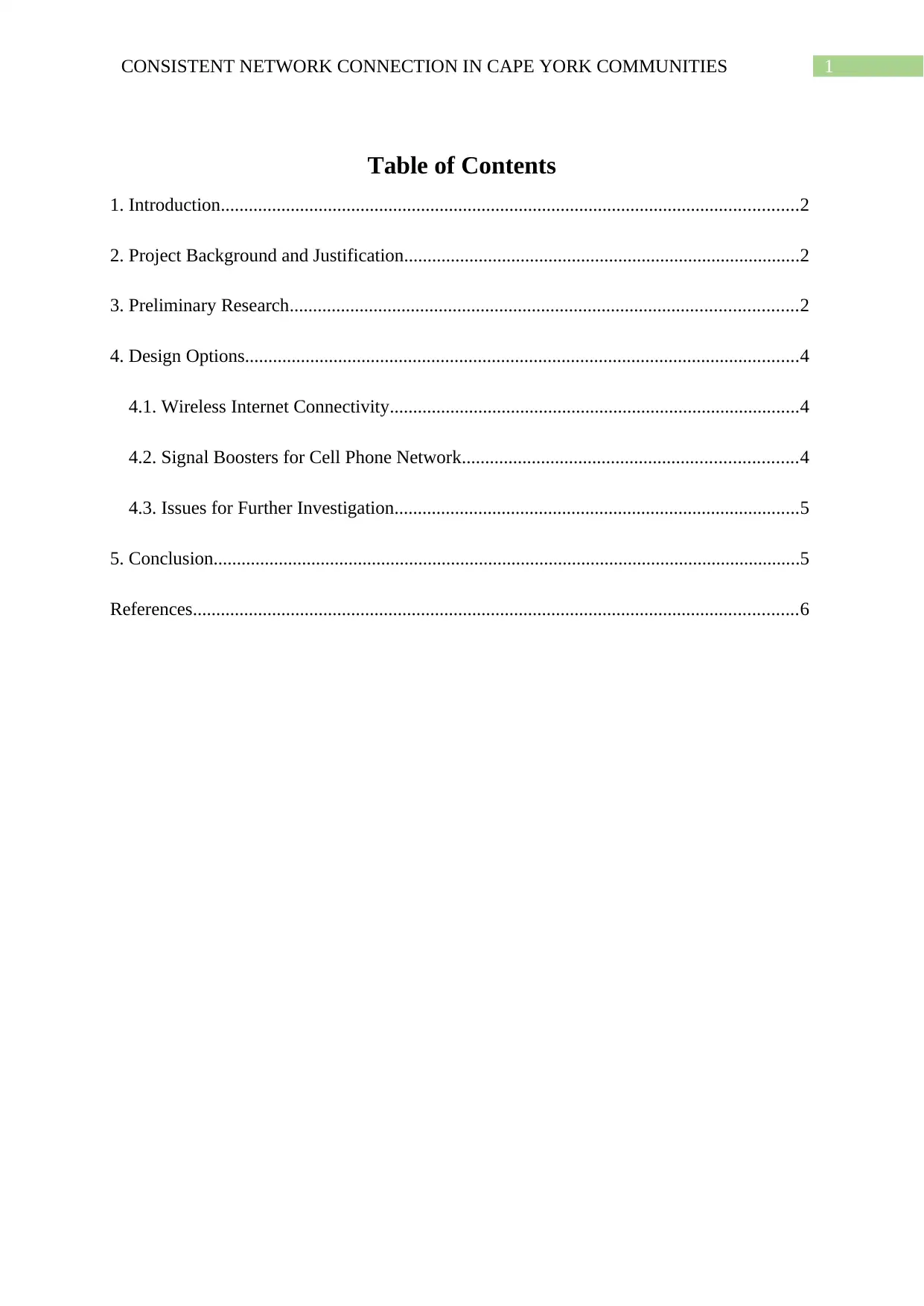
1CONSISTENT NETWORK CONNECTION IN CAPE YORK COMMUNITIES
Table of Contents
1. Introduction............................................................................................................................2
2. Project Background and Justification.....................................................................................2
3. Preliminary Research.............................................................................................................2
4. Design Options.......................................................................................................................4
4.1. Wireless Internet Connectivity........................................................................................4
4.2. Signal Boosters for Cell Phone Network........................................................................4
4.3. Issues for Further Investigation.......................................................................................5
5. Conclusion..............................................................................................................................5
References..................................................................................................................................6
Table of Contents
1. Introduction............................................................................................................................2
2. Project Background and Justification.....................................................................................2
3. Preliminary Research.............................................................................................................2
4. Design Options.......................................................................................................................4
4.1. Wireless Internet Connectivity........................................................................................4
4.2. Signal Boosters for Cell Phone Network........................................................................4
4.3. Issues for Further Investigation.......................................................................................5
5. Conclusion..............................................................................................................................5
References..................................................................................................................................6

2CONSISTENT NETWORK CONNECTION IN CAPE YORK COMMUNITIES
1. Introduction
The assignment aims to discuss the communication issues faced by the communities
of Cape York Peninsula due to concentrating signals from the existing towers of
communication. The report also proposes two justified design solutions that will help to
improve the network and data coverage in the remote homelands and enhance the
communication process.
2. Project Background and Justification
The indigenous people of the dispersed communities in the Cape York Peninsula of
the Queensland region do not have a stable network coverage of their mobile phones and face
issues to establish a consistent communication amongst the people (Du, 2017). The region is
already a remote location that comprises of poor network coverage due to the concentrating
signals in the communication towers (Salemink, Strijker & Bosworth, 2017). The community
also lacks Internet access in their households and only a few Internet cafés are present in these
remote locations for the people to access them in case of fulfilling any purpose online.
The mobile hotspot developed by CfAT also facilitates with only one user at a time
that limits the access of Internet by the users. Due to the unavailability of the Internet, the
residents cannot access to online banking services or retail shopping (Martin, 2018).
Moreover, the young people is lacking internet surfing skills and are lagging behind in terms
of literacy rate than the urban people. Thus, this remote area requires smooth and consistent
Internet connection for the technological progress of the society.
3. Preliminary Research
Kohen, A., & Spanodine, B. (2016). Switching on the remote: a new perspective on
accessibility in remote Australia.
The people from various remote locations of Australia lack from enjoying benefits of
digital revolution because they cannot afford adequate infrastructure, or affordable and
reliable services. Due to the absence of digital infrastructure as per the current technologies
available in the developed parts of the nation, the people from these remote locations suffer
from slower rate of service delivery including lack of education as well as health services.
The economic development of these regions are also reduced at a significant rate due to
1. Introduction
The assignment aims to discuss the communication issues faced by the communities
of Cape York Peninsula due to concentrating signals from the existing towers of
communication. The report also proposes two justified design solutions that will help to
improve the network and data coverage in the remote homelands and enhance the
communication process.
2. Project Background and Justification
The indigenous people of the dispersed communities in the Cape York Peninsula of
the Queensland region do not have a stable network coverage of their mobile phones and face
issues to establish a consistent communication amongst the people (Du, 2017). The region is
already a remote location that comprises of poor network coverage due to the concentrating
signals in the communication towers (Salemink, Strijker & Bosworth, 2017). The community
also lacks Internet access in their households and only a few Internet cafés are present in these
remote locations for the people to access them in case of fulfilling any purpose online.
The mobile hotspot developed by CfAT also facilitates with only one user at a time
that limits the access of Internet by the users. Due to the unavailability of the Internet, the
residents cannot access to online banking services or retail shopping (Martin, 2018).
Moreover, the young people is lacking internet surfing skills and are lagging behind in terms
of literacy rate than the urban people. Thus, this remote area requires smooth and consistent
Internet connection for the technological progress of the society.
3. Preliminary Research
Kohen, A., & Spanodine, B. (2016). Switching on the remote: a new perspective on
accessibility in remote Australia.
The people from various remote locations of Australia lack from enjoying benefits of
digital revolution because they cannot afford adequate infrastructure, or affordable and
reliable services. Due to the absence of digital infrastructure as per the current technologies
available in the developed parts of the nation, the people from these remote locations suffer
from slower rate of service delivery including lack of education as well as health services.
The economic development of these regions are also reduced at a significant rate due to
⊘ This is a preview!⊘
Do you want full access?
Subscribe today to unlock all pages.

Trusted by 1+ million students worldwide
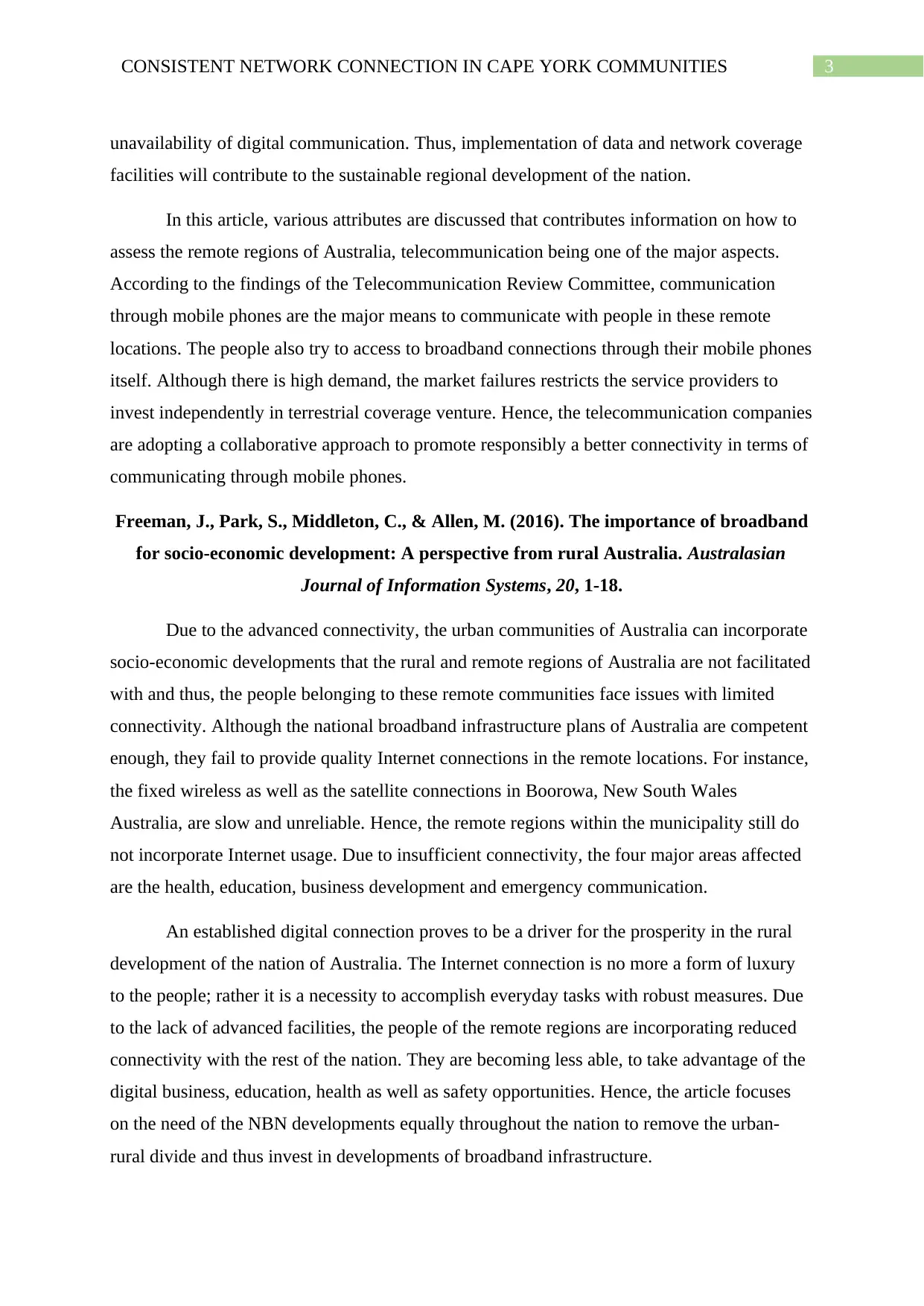
3CONSISTENT NETWORK CONNECTION IN CAPE YORK COMMUNITIES
unavailability of digital communication. Thus, implementation of data and network coverage
facilities will contribute to the sustainable regional development of the nation.
In this article, various attributes are discussed that contributes information on how to
assess the remote regions of Australia, telecommunication being one of the major aspects.
According to the findings of the Telecommunication Review Committee, communication
through mobile phones are the major means to communicate with people in these remote
locations. The people also try to access to broadband connections through their mobile phones
itself. Although there is high demand, the market failures restricts the service providers to
invest independently in terrestrial coverage venture. Hence, the telecommunication companies
are adopting a collaborative approach to promote responsibly a better connectivity in terms of
communicating through mobile phones.
Freeman, J., Park, S., Middleton, C., & Allen, M. (2016). The importance of broadband
for socio-economic development: A perspective from rural Australia. Australasian
Journal of Information Systems, 20, 1-18.
Due to the advanced connectivity, the urban communities of Australia can incorporate
socio-economic developments that the rural and remote regions of Australia are not facilitated
with and thus, the people belonging to these remote communities face issues with limited
connectivity. Although the national broadband infrastructure plans of Australia are competent
enough, they fail to provide quality Internet connections in the remote locations. For instance,
the fixed wireless as well as the satellite connections in Boorowa, New South Wales
Australia, are slow and unreliable. Hence, the remote regions within the municipality still do
not incorporate Internet usage. Due to insufficient connectivity, the four major areas affected
are the health, education, business development and emergency communication.
An established digital connection proves to be a driver for the prosperity in the rural
development of the nation of Australia. The Internet connection is no more a form of luxury
to the people; rather it is a necessity to accomplish everyday tasks with robust measures. Due
to the lack of advanced facilities, the people of the remote regions are incorporating reduced
connectivity with the rest of the nation. They are becoming less able, to take advantage of the
digital business, education, health as well as safety opportunities. Hence, the article focuses
on the need of the NBN developments equally throughout the nation to remove the urban-
rural divide and thus invest in developments of broadband infrastructure.
unavailability of digital communication. Thus, implementation of data and network coverage
facilities will contribute to the sustainable regional development of the nation.
In this article, various attributes are discussed that contributes information on how to
assess the remote regions of Australia, telecommunication being one of the major aspects.
According to the findings of the Telecommunication Review Committee, communication
through mobile phones are the major means to communicate with people in these remote
locations. The people also try to access to broadband connections through their mobile phones
itself. Although there is high demand, the market failures restricts the service providers to
invest independently in terrestrial coverage venture. Hence, the telecommunication companies
are adopting a collaborative approach to promote responsibly a better connectivity in terms of
communicating through mobile phones.
Freeman, J., Park, S., Middleton, C., & Allen, M. (2016). The importance of broadband
for socio-economic development: A perspective from rural Australia. Australasian
Journal of Information Systems, 20, 1-18.
Due to the advanced connectivity, the urban communities of Australia can incorporate
socio-economic developments that the rural and remote regions of Australia are not facilitated
with and thus, the people belonging to these remote communities face issues with limited
connectivity. Although the national broadband infrastructure plans of Australia are competent
enough, they fail to provide quality Internet connections in the remote locations. For instance,
the fixed wireless as well as the satellite connections in Boorowa, New South Wales
Australia, are slow and unreliable. Hence, the remote regions within the municipality still do
not incorporate Internet usage. Due to insufficient connectivity, the four major areas affected
are the health, education, business development and emergency communication.
An established digital connection proves to be a driver for the prosperity in the rural
development of the nation of Australia. The Internet connection is no more a form of luxury
to the people; rather it is a necessity to accomplish everyday tasks with robust measures. Due
to the lack of advanced facilities, the people of the remote regions are incorporating reduced
connectivity with the rest of the nation. They are becoming less able, to take advantage of the
digital business, education, health as well as safety opportunities. Hence, the article focuses
on the need of the NBN developments equally throughout the nation to remove the urban-
rural divide and thus invest in developments of broadband infrastructure.
Paraphrase This Document
Need a fresh take? Get an instant paraphrase of this document with our AI Paraphraser
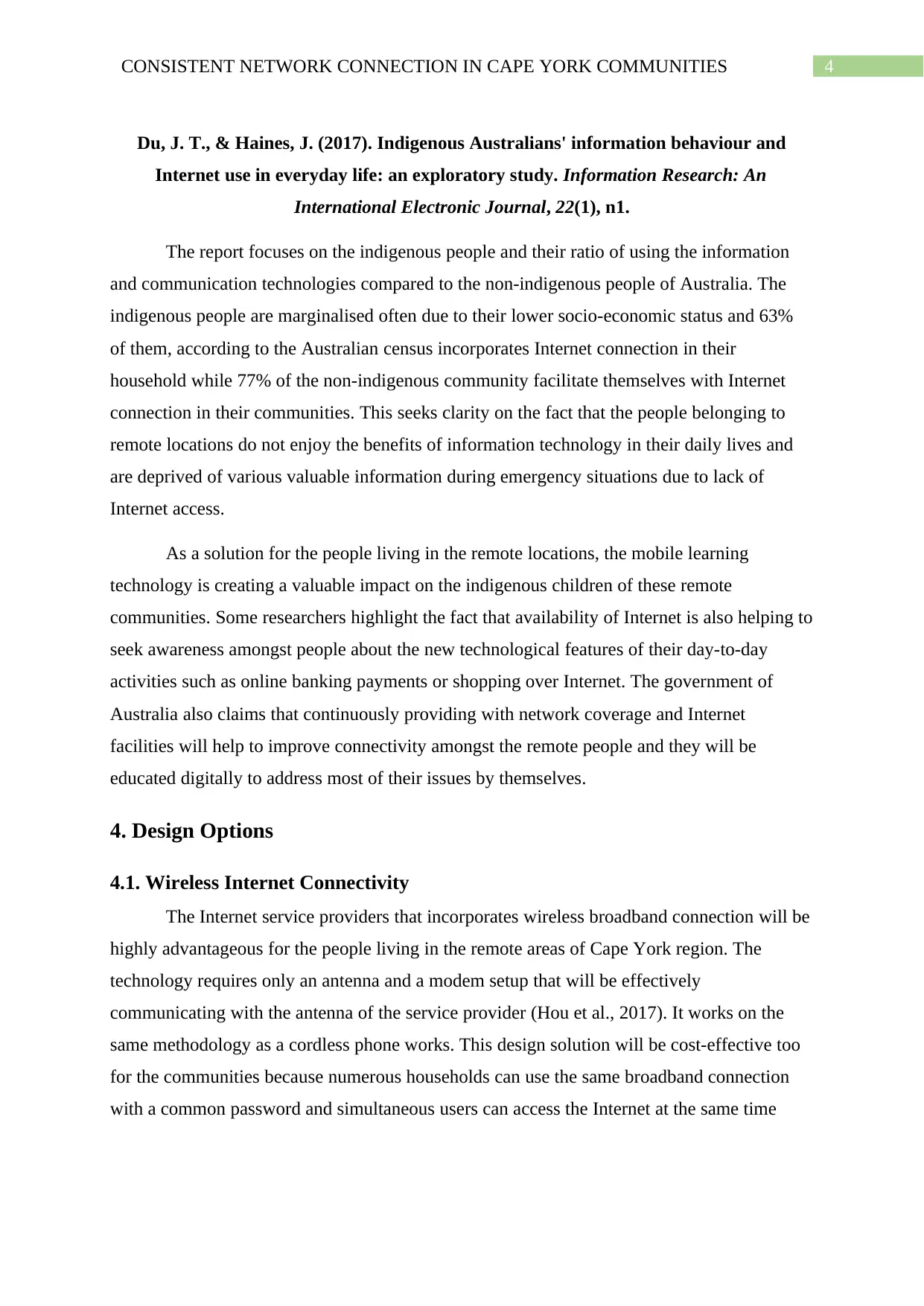
4CONSISTENT NETWORK CONNECTION IN CAPE YORK COMMUNITIES
Du, J. T., & Haines, J. (2017). Indigenous Australians' information behaviour and
Internet use in everyday life: an exploratory study. Information Research: An
International Electronic Journal, 22(1), n1.
The report focuses on the indigenous people and their ratio of using the information
and communication technologies compared to the non-indigenous people of Australia. The
indigenous people are marginalised often due to their lower socio-economic status and 63%
of them, according to the Australian census incorporates Internet connection in their
household while 77% of the non-indigenous community facilitate themselves with Internet
connection in their communities. This seeks clarity on the fact that the people belonging to
remote locations do not enjoy the benefits of information technology in their daily lives and
are deprived of various valuable information during emergency situations due to lack of
Internet access.
As a solution for the people living in the remote locations, the mobile learning
technology is creating a valuable impact on the indigenous children of these remote
communities. Some researchers highlight the fact that availability of Internet is also helping to
seek awareness amongst people about the new technological features of their day-to-day
activities such as online banking payments or shopping over Internet. The government of
Australia also claims that continuously providing with network coverage and Internet
facilities will help to improve connectivity amongst the remote people and they will be
educated digitally to address most of their issues by themselves.
4. Design Options
4.1. Wireless Internet Connectivity
The Internet service providers that incorporates wireless broadband connection will be
highly advantageous for the people living in the remote areas of Cape York region. The
technology requires only an antenna and a modem setup that will be effectively
communicating with the antenna of the service provider (Hou et al., 2017). It works on the
same methodology as a cordless phone works. This design solution will be cost-effective too
for the communities because numerous households can use the same broadband connection
with a common password and simultaneous users can access the Internet at the same time
Du, J. T., & Haines, J. (2017). Indigenous Australians' information behaviour and
Internet use in everyday life: an exploratory study. Information Research: An
International Electronic Journal, 22(1), n1.
The report focuses on the indigenous people and their ratio of using the information
and communication technologies compared to the non-indigenous people of Australia. The
indigenous people are marginalised often due to their lower socio-economic status and 63%
of them, according to the Australian census incorporates Internet connection in their
household while 77% of the non-indigenous community facilitate themselves with Internet
connection in their communities. This seeks clarity on the fact that the people belonging to
remote locations do not enjoy the benefits of information technology in their daily lives and
are deprived of various valuable information during emergency situations due to lack of
Internet access.
As a solution for the people living in the remote locations, the mobile learning
technology is creating a valuable impact on the indigenous children of these remote
communities. Some researchers highlight the fact that availability of Internet is also helping to
seek awareness amongst people about the new technological features of their day-to-day
activities such as online banking payments or shopping over Internet. The government of
Australia also claims that continuously providing with network coverage and Internet
facilities will help to improve connectivity amongst the remote people and they will be
educated digitally to address most of their issues by themselves.
4. Design Options
4.1. Wireless Internet Connectivity
The Internet service providers that incorporates wireless broadband connection will be
highly advantageous for the people living in the remote areas of Cape York region. The
technology requires only an antenna and a modem setup that will be effectively
communicating with the antenna of the service provider (Hou et al., 2017). It works on the
same methodology as a cordless phone works. This design solution will be cost-effective too
for the communities because numerous households can use the same broadband connection
with a common password and simultaneous users can access the Internet at the same time
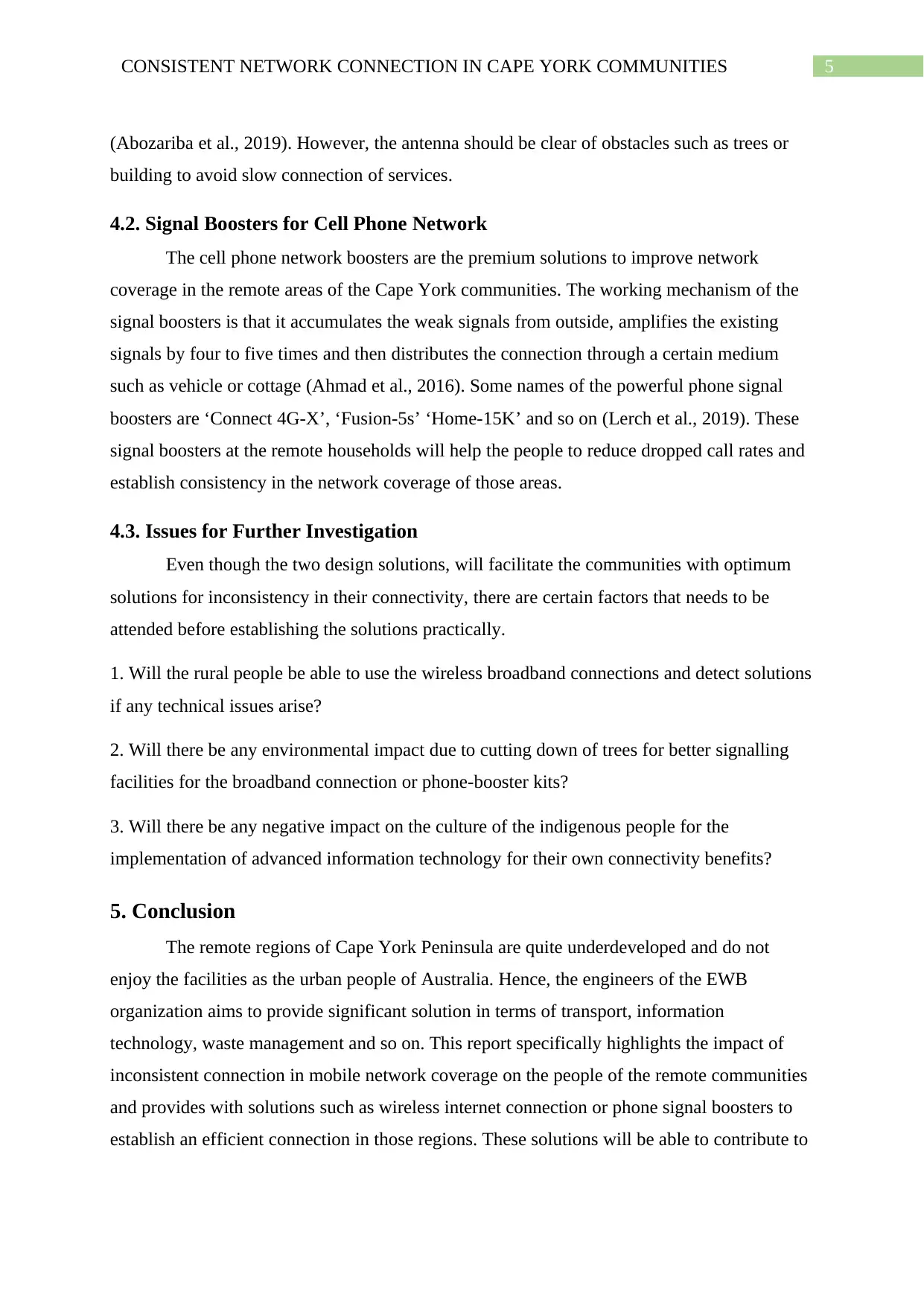
5CONSISTENT NETWORK CONNECTION IN CAPE YORK COMMUNITIES
(Abozariba et al., 2019). However, the antenna should be clear of obstacles such as trees or
building to avoid slow connection of services.
4.2. Signal Boosters for Cell Phone Network
The cell phone network boosters are the premium solutions to improve network
coverage in the remote areas of the Cape York communities. The working mechanism of the
signal boosters is that it accumulates the weak signals from outside, amplifies the existing
signals by four to five times and then distributes the connection through a certain medium
such as vehicle or cottage (Ahmad et al., 2016). Some names of the powerful phone signal
boosters are ‘Connect 4G-X’, ‘Fusion-5s’ ‘Home-15K’ and so on (Lerch et al., 2019). These
signal boosters at the remote households will help the people to reduce dropped call rates and
establish consistency in the network coverage of those areas.
4.3. Issues for Further Investigation
Even though the two design solutions, will facilitate the communities with optimum
solutions for inconsistency in their connectivity, there are certain factors that needs to be
attended before establishing the solutions practically.
1. Will the rural people be able to use the wireless broadband connections and detect solutions
if any technical issues arise?
2. Will there be any environmental impact due to cutting down of trees for better signalling
facilities for the broadband connection or phone-booster kits?
3. Will there be any negative impact on the culture of the indigenous people for the
implementation of advanced information technology for their own connectivity benefits?
5. Conclusion
The remote regions of Cape York Peninsula are quite underdeveloped and do not
enjoy the facilities as the urban people of Australia. Hence, the engineers of the EWB
organization aims to provide significant solution in terms of transport, information
technology, waste management and so on. This report specifically highlights the impact of
inconsistent connection in mobile network coverage on the people of the remote communities
and provides with solutions such as wireless internet connection or phone signal boosters to
establish an efficient connection in those regions. These solutions will be able to contribute to
(Abozariba et al., 2019). However, the antenna should be clear of obstacles such as trees or
building to avoid slow connection of services.
4.2. Signal Boosters for Cell Phone Network
The cell phone network boosters are the premium solutions to improve network
coverage in the remote areas of the Cape York communities. The working mechanism of the
signal boosters is that it accumulates the weak signals from outside, amplifies the existing
signals by four to five times and then distributes the connection through a certain medium
such as vehicle or cottage (Ahmad et al., 2016). Some names of the powerful phone signal
boosters are ‘Connect 4G-X’, ‘Fusion-5s’ ‘Home-15K’ and so on (Lerch et al., 2019). These
signal boosters at the remote households will help the people to reduce dropped call rates and
establish consistency in the network coverage of those areas.
4.3. Issues for Further Investigation
Even though the two design solutions, will facilitate the communities with optimum
solutions for inconsistency in their connectivity, there are certain factors that needs to be
attended before establishing the solutions practically.
1. Will the rural people be able to use the wireless broadband connections and detect solutions
if any technical issues arise?
2. Will there be any environmental impact due to cutting down of trees for better signalling
facilities for the broadband connection or phone-booster kits?
3. Will there be any negative impact on the culture of the indigenous people for the
implementation of advanced information technology for their own connectivity benefits?
5. Conclusion
The remote regions of Cape York Peninsula are quite underdeveloped and do not
enjoy the facilities as the urban people of Australia. Hence, the engineers of the EWB
organization aims to provide significant solution in terms of transport, information
technology, waste management and so on. This report specifically highlights the impact of
inconsistent connection in mobile network coverage on the people of the remote communities
and provides with solutions such as wireless internet connection or phone signal boosters to
establish an efficient connection in those regions. These solutions will be able to contribute to
⊘ This is a preview!⊘
Do you want full access?
Subscribe today to unlock all pages.

Trusted by 1+ million students worldwide

6CONSISTENT NETWORK CONNECTION IN CAPE YORK COMMUNITIES
the development of the socio-economic status of the people and try to minimize the rural-
urban gap of the nation.
the development of the socio-economic status of the people and try to minimize the rural-
urban gap of the nation.
Paraphrase This Document
Need a fresh take? Get an instant paraphrase of this document with our AI Paraphraser
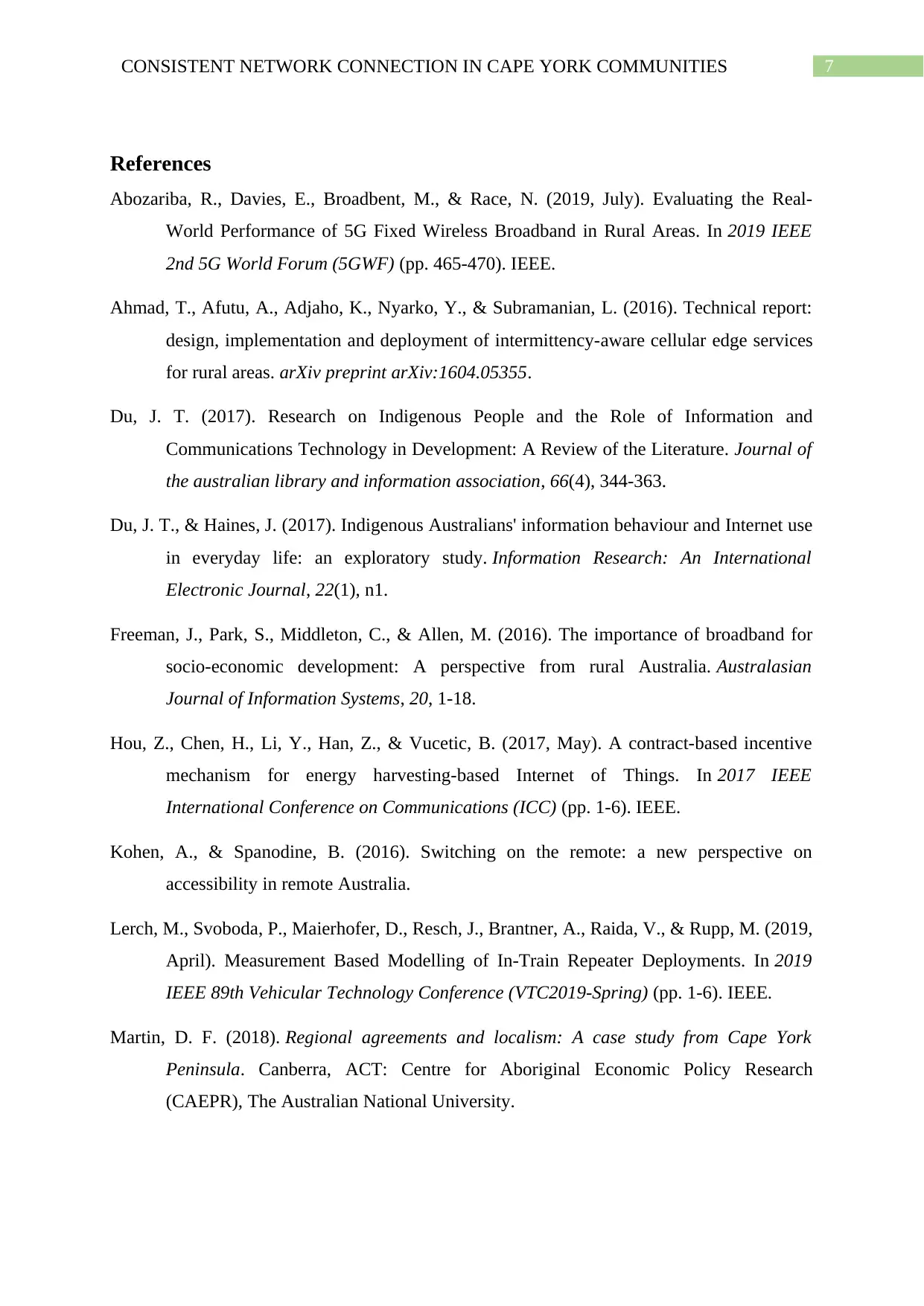
7CONSISTENT NETWORK CONNECTION IN CAPE YORK COMMUNITIES
References
Abozariba, R., Davies, E., Broadbent, M., & Race, N. (2019, July). Evaluating the Real-
World Performance of 5G Fixed Wireless Broadband in Rural Areas. In 2019 IEEE
2nd 5G World Forum (5GWF) (pp. 465-470). IEEE.
Ahmad, T., Afutu, A., Adjaho, K., Nyarko, Y., & Subramanian, L. (2016). Technical report:
design, implementation and deployment of intermittency-aware cellular edge services
for rural areas. arXiv preprint arXiv:1604.05355.
Du, J. T. (2017). Research on Indigenous People and the Role of Information and
Communications Technology in Development: A Review of the Literature. Journal of
the australian library and information association, 66(4), 344-363.
Du, J. T., & Haines, J. (2017). Indigenous Australians' information behaviour and Internet use
in everyday life: an exploratory study. Information Research: An International
Electronic Journal, 22(1), n1.
Freeman, J., Park, S., Middleton, C., & Allen, M. (2016). The importance of broadband for
socio-economic development: A perspective from rural Australia. Australasian
Journal of Information Systems, 20, 1-18.
Hou, Z., Chen, H., Li, Y., Han, Z., & Vucetic, B. (2017, May). A contract-based incentive
mechanism for energy harvesting-based Internet of Things. In 2017 IEEE
International Conference on Communications (ICC) (pp. 1-6). IEEE.
Kohen, A., & Spanodine, B. (2016). Switching on the remote: a new perspective on
accessibility in remote Australia.
Lerch, M., Svoboda, P., Maierhofer, D., Resch, J., Brantner, A., Raida, V., & Rupp, M. (2019,
April). Measurement Based Modelling of In-Train Repeater Deployments. In 2019
IEEE 89th Vehicular Technology Conference (VTC2019-Spring) (pp. 1-6). IEEE.
Martin, D. F. (2018). Regional agreements and localism: A case study from Cape York
Peninsula. Canberra, ACT: Centre for Aboriginal Economic Policy Research
(CAEPR), The Australian National University.
References
Abozariba, R., Davies, E., Broadbent, M., & Race, N. (2019, July). Evaluating the Real-
World Performance of 5G Fixed Wireless Broadband in Rural Areas. In 2019 IEEE
2nd 5G World Forum (5GWF) (pp. 465-470). IEEE.
Ahmad, T., Afutu, A., Adjaho, K., Nyarko, Y., & Subramanian, L. (2016). Technical report:
design, implementation and deployment of intermittency-aware cellular edge services
for rural areas. arXiv preprint arXiv:1604.05355.
Du, J. T. (2017). Research on Indigenous People and the Role of Information and
Communications Technology in Development: A Review of the Literature. Journal of
the australian library and information association, 66(4), 344-363.
Du, J. T., & Haines, J. (2017). Indigenous Australians' information behaviour and Internet use
in everyday life: an exploratory study. Information Research: An International
Electronic Journal, 22(1), n1.
Freeman, J., Park, S., Middleton, C., & Allen, M. (2016). The importance of broadband for
socio-economic development: A perspective from rural Australia. Australasian
Journal of Information Systems, 20, 1-18.
Hou, Z., Chen, H., Li, Y., Han, Z., & Vucetic, B. (2017, May). A contract-based incentive
mechanism for energy harvesting-based Internet of Things. In 2017 IEEE
International Conference on Communications (ICC) (pp. 1-6). IEEE.
Kohen, A., & Spanodine, B. (2016). Switching on the remote: a new perspective on
accessibility in remote Australia.
Lerch, M., Svoboda, P., Maierhofer, D., Resch, J., Brantner, A., Raida, V., & Rupp, M. (2019,
April). Measurement Based Modelling of In-Train Repeater Deployments. In 2019
IEEE 89th Vehicular Technology Conference (VTC2019-Spring) (pp. 1-6). IEEE.
Martin, D. F. (2018). Regional agreements and localism: A case study from Cape York
Peninsula. Canberra, ACT: Centre for Aboriginal Economic Policy Research
(CAEPR), The Australian National University.

8CONSISTENT NETWORK CONNECTION IN CAPE YORK COMMUNITIES
Salemink, K., Strijker, D., & Bosworth, G. (2017). Rural development in the digital age: A
systematic literature review on unequal ICT availability, adoption, and use in rural
areas. Journal of Rural Studies, 54, 360-371.
Salemink, K., Strijker, D., & Bosworth, G. (2017). Rural development in the digital age: A
systematic literature review on unequal ICT availability, adoption, and use in rural
areas. Journal of Rural Studies, 54, 360-371.
⊘ This is a preview!⊘
Do you want full access?
Subscribe today to unlock all pages.

Trusted by 1+ million students worldwide
1 out of 9
Related Documents
Your All-in-One AI-Powered Toolkit for Academic Success.
+13062052269
info@desklib.com
Available 24*7 on WhatsApp / Email
![[object Object]](/_next/static/media/star-bottom.7253800d.svg)
Unlock your academic potential
Copyright © 2020–2025 A2Z Services. All Rights Reserved. Developed and managed by ZUCOL.





